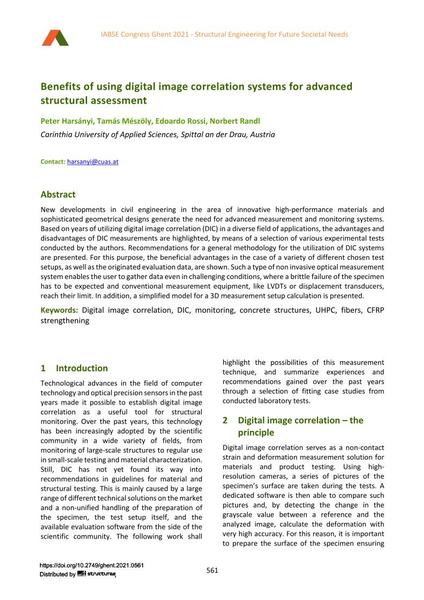Benefits of using digital image correlation systems for advanced structural assessment

|
|
|||||||||||
Bibliografische Angaben
| Autor(en): |
Peter Harsányi
(Carinthia University of Applied Sciences, Spittal an der Drau, Austria)
Tamás Mészöly (Carinthia University of Applied Sciences, Spittal an der Drau, Austria) Edoardo Rossi (Carinthia University of Applied Sciences, Spittal an der Drau, Austria) Norbert Randl (Carinthia University of Applied Sciences, Spittal an der Drau, Austria) |
||||
|---|---|---|---|---|---|
| Medium: | Tagungsbeitrag | ||||
| Sprache(n): | Englisch | ||||
| Tagung: | IABSE Congress: Structural Engineering for Future Societal Needs, Ghent, Belgium, 22-24 September 2021 | ||||
| Veröffentlicht in: | IABSE Congress Ghent 2021 | ||||
|
|||||
| Seite(n): | 561-570 | ||||
| Anzahl der Seiten (im PDF): | 10 | ||||
| DOI: | 10.2749/ghent.2021.0561 | ||||
| Abstrakt: |
New developments in civil engineering in the area of innovative high-performance materials and sophisticated geometrical designs generate the need for advanced measurement and monitoring systems. Based on years of utilizing digital image correlation (DIC) in a diverse field of applications, the advantages and disadvantages of DIC measurements are highlighted, by means of a selection of various experimental tests conducted by the authors. Recommendations for a general methodology for the utilization of DIC systems are presented. For this purpose, the beneficial advantages in the case of a variety of different chosen test setups, as well as the originated evaluation data, are shown. Such a type of non invasive optical measurement system enables the user to gather data even in challenging conditions, where a brittle failure of the specimen has to be expected and conventional measurement equipment, like LVDTs or displacement transducers, reach their limit. In addition, a simplified model for a 3D measurement setup calculation is presented. |
||||
| Stichwörter: |
Monitoring UHPC
|
||||
| Copyright: | © 2021 International Association for Bridge and Structural Engineering (IABSE) | ||||
| Lizenz: | Die Urheberrechte (Copyright) für dieses Werk sind rechtlich geschützt. Es darf nicht ohne die Zustimmung des Autors/der Autorin oder Rechteinhabers/-in weiter benutzt werden. |
||||
